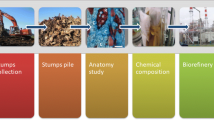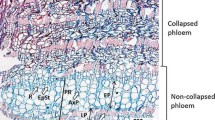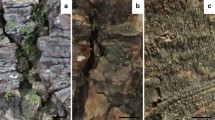Abstract
The root bark structure of Quercus robur L. was analysed at different stages of root development and compared to the structure of stem bark. Root bark thickness varied considerably between different roots. Sclereid quantity decreased with increasing distance from the stem, which means it increased with age. Visible growth increments diminished with increasing distance from the stem. In lateral roots crystal quantity decreased with increasing distance from the stem. In lateral roots secondary phloem fibre length, sieve tube member length, and sieve tube diameter showed no regular trend. There were only a few basic structural differences between root and stem bark. The zone of cell differentiation (cell expansion, lignification) was wider in root bark; sieve tube collapse was delayed. In lateral root bark fewer sclereids were formed. The first-formed periderm often originated from deeper cell layers. Thus, primary elements were lacking after periderm formation. In root bark the phellem cell walls were of equal thickness. Thus, phellem lacked visible growth increments. Root bark phellem cells were slightly larger. The root phelloderm was more distinct. The secondary phloem fibres were slightly shorter than those in stem bark. Sieve tube members of stem and root bark were of similar length and diameter. The qualitative bark anatomical characters of oak root bark are suitable for root identifications. Due to minor structural differences between root and stem bark the characters must be used with care.
Similar content being viewed by others
References
Aloni R (1987) Differentiation of vascular tissues. Annu Rev Plant Physiol 38: 179–204
Aloni R, Gad AE (1982) Anatomy of the primary phloem fiber system in Pisum sativum. Am J Bot 69: 979–984
Alten H von (1908) Beiträge zur vergleichenden Anatomie der Wurzeln, nebst Bemerkungen über Wurzelthyllen, Heterorhizie, Lenticellen. Dissertation, University of Göttingen
Archer RH, Wyk AE van (1993) Bark structure and intergeneric relationships of some African Cassinoideae (Celastraceae). IAWA J 14: 35–53
Blunden G, Aye Kyi, Jewers K (1974) The comparative stem and root anatomy of Goniothalamus andersonii, G. macrophyllus, G. malayanus and G. velutinus (Annonaceae) from the peat swamps of Sarawak. Bot J Linn Soc 68: 209–225
Casparis P (1918) Beiträge zur Anatomie der Simarubaceenrinden. Dissertation, University of Basel
Chang YP (1954) Anatomy of common North American pulpwood barks. TAPPI Monographs Series No 14
Cheadle VI, Esau K (1958) Secondary phloem of Calycanthaceae. Univ Calif Publ Bot 29: 60–67
Cutler DF, Rudall PJ, Gasson PE, Gale RMO (1987) Root identification manual of trees and shrubs. Chapman and Hall, London
Datta SK, Datta PC (1976) Bark drugs of Plumeria. Q J Crude Drug Res 14: 129–142
Douliot H (1889) Recherches sur le périderme. Ann Sci Nat Bot 10: 325–395
Eremin VM, Maksimov VM (1973) Differences in the anatomical structure of root bark and stem bark of Scots Pine (in Russian). Lesnoi Zhurnal (Voronezh) 16: 5–9
Eremin VM, Sivak SV (1977) Differences of root bark and stem bark in some conifers (in Russian). Lesnoi Zhurnal (Voronezh) 20: 5–9
Esau K (1969) The phloem. Handbuch der Pflanzenanatomie, vol 5/2. Gebrüder Borntraeger, Berlin
Esau K (1977) Anatomy of seed plants. 2nd edn. Wiley, New York
Esau K, Cheadle VI (1955) Significance of cell divisions in differentiating secondary phloem. Acta Bot Neerl 4: 346–357
Gasson PE (1979) The identification of eight woody genera of the Caprifoliaceae by selected features of their root anatomy. Bot J Linn Soc 78: 267–284
Gerlach D (1969) Botanische Mikrotechnik. Thieme, Stuttgart
Haberlandt G (1918) Physiologische Pflanzenanatomie. 5th edn. W Engelmann, Leipzig
Holdheide W (1951) Anatomie mitteleuropäischer Gehölzrinden. In: Freund H (ed) Handbuch der Mikroskopie in der Technik, vol V/1. Umschau, Frankfurt/Main, pp 193–367
Huber B (1939) Das Siebröhrensystem unserer Bäume und seine jahreszeitlichen Veränderungen. Jahrb Wiss Bot 88: 176–242
Kny L (1908) Ueber das Dickenwachstum des Holzkörpers der Wurzeln in seiner Beziehung zur Lotlinie. Ber Dtsch Bot Ges 26: 19–50
Liese J (1926) Beiträge zur Kenntnis des Wurzelsystems der Kiefer (Pinus sylvestris). Habilitationsschrift Forstliche Hochschule Eberswalde. Springer, Berlin Heidelberg New York
MacDaniels LH (1918) The histology of the phloem in certain woody angiosperms. Am J Bot 5: 347–378
Parameswaran N, Liese W (1968) Beitrag zur Rindenanatomie der Gattung Entandophragma. Flora (Jena) Abt B 158: 22–40
Riedel H (1937) Bau und Leistungen des Wurzelholzes. Dissertation Technische Hochschule Dresden. Gebrüder Borntraeger, Leipzig
Rusch J (1973) Vergleichende anatomische Untersuchungen des Holzes von Wurzel und Stamm bei verschiedenen Laubbaumarten. Dissertation, University of Freiburg
Trockenbrodt M (1990) Survey and discussion of the terminology used in bark anatomy. IAWA Bull ns 11: 141–166
Trockenbrodt M (1991) Qualitative structural changes during bark development in Quercus robur, Ultnus glabra, Populus tremula and Betula pendula. IAWA Bull ns 12: 5–22
Trockenbrodt M (1994) Quantitative changes of some anatomical characters during bark development in Quercus robur, Ulmus glabra, Populus tremula and Betula pendula. IAWA J 15: 387–398
Trockenbrodt M (1995) Calcium oxalate crystals in the bark of Quercus robur, Ulmus glabra, Populus tremula and Betula pendula. Ann Bot 73 (in press)
Vurdu H, Bensend DW (1979) Specific gravity and fiber length in European Black Alder roots, branches, and stems. Wood Sci 12: 103–105
Wieler A (1891) Ueber die Beziehung zwischen Wurzel- und Stammholz. Tharandter Forstl Jahrb 41: 143–171
Wyk AE van (1985) The genus Eugenia (Myrtaceae) in southern Africa: structure and taxonomic value of the bark. S Afr J Bot 51: 157–180
Author information
Authors and Affiliations
Rights and permissions
About this article
Cite this article
Trockenbrodt, M. Structure and identification of root bark of Quercus robur L.. Trees 9, 341–347 (1995). https://doi.org/10.1007/BF00202498
Issue Date:
DOI: https://doi.org/10.1007/BF00202498




